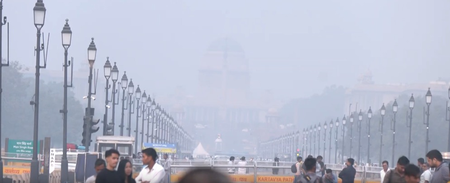CPCB tightens pollution restrictions in Delhi as air quality stays toxic

New Delhi, Nov 22 (IANS) With Delhi’s air quality turning toxic, the Central Pollution Control Board (CPCB) on Saturday tightened pollution-control measures, directing that several restrictions currently reserved for the ‘Severe’ category under GRAP Stage IV be implemented earlier under GRAP Stage III as air quality remains in the ‘Very Poor’ range.
As part of the updated directions, the Delhi government and NCR authorities will decide whether public, municipal, and private offices should function with only half their workforce on site, allowing the remaining staff to work remotely.
The panel has also said that the Central Government may take an appropriate decision on permitting work-from-home arrangements for employees of central government offices.
Meanwhile on Saturday, Delhi-NCR woke up to another day of hazardous pollution, as air quality levels plunged deep into the ‘severe plus’ category, posing serious health risks to residents. According to air quality tracker aqi.in, Delhi recorded an alarming Air Quality Index (AQI) of 447 at 7 a.m. Several monitoring stations recorded AQI levels above 500, pushing pollution into the ‘severe plus’ zone, where air becomes practically unbreathable.
The concentration of PM 2.5, the most harmful and fine pollutant, soared to 312 micrograms per cubic metre at 7 a.m., while PM 10 levels touched 422 micrograms per cubic metre.
These numbers exceed the World Health Organisation (WHO) 24-hour safe limits by a staggering margin. WHO guidelines state that PM 2.5 should remain below 15 micrograms per cubic metre and PM 10 should not cross 45 micrograms per cubic metre, making the current levels more than 20 times the recommended threshold.
Residents across Delhi, Noida, Ghaziabad, Faridabad, and Gurgaon reported waking up to a thick blanket of smog that has persisted through the week.
Earlier visibility has dropped significantly, remaining between 800 and 900 metres on Friday morning, according to the Early Warning System for Delhi. The persistently low visibility has disrupted daily routines and increased health concerns, particularly among vulnerable groups.
Air quality in neighbouring regions painted an equally grim picture. Greater Noida registered an AQI of 495 at 7 a.m., inching dangerously close to the upper limit of the index. Noida followed with 462, Faridabad with 448, Gurgaon with 454, and Meerut with 443, all falling under the ‘severe’ category.
Weather conditions have further contributed to the crisis. Morning fog is expected to continue across major cities like Delhi, while daytime temperatures are likely to remain cool, with the maximum hovering around 24 degrees celsius. Early Saturday saw many parts of the national Capital engulfed in dense smog that offered little relief throughout the day.
Night-time temperatures have also dipped noticeably. At the Safdarjung weather station, the minimum temperature fell to 11.2 degrees celsius on Friday, 1.1 degrees below normal and slightly lower than Thursday’s measurement. Forecasts suggest that temperatures may fluctuate between 9 degrees celsius and 11 degrees celsius over the next few days.
As pollution levels remain hazardous and the cold intensifies, medical professionals advise residents to stay indoors as much as possible, use high-quality masks, and avoid strenuous outdoor activities.
The worsening conditions have once again raised urgent questions about long-term solutions to Delhi-NCR’s air pollution crisis.
–IANS
jk/rad




